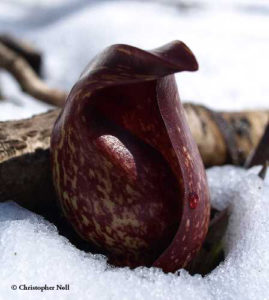
QUIZ: Skunk Cabbage – A Sure Sign Spring Has Sprung?

An inevitable first sign of spring are blooms of the skunk cabbage. Shyly hidden underneath leaf litter, they protrude through the last remains of snow, sometimes as early as late February! They can be found in the swampy wet areas of forest floors. Have you spotted one in your woods?
You might be familiar with the look of the skunk cabbage later in the season as they grow taller and their leaves unfurl. However, their mottled purple or wine-stained, flowers are unmistakable as they poke through the ground in early spring. They just may be hard to spot underneath leaf litter and snow. Quite an inhospitable place to grow, but the skunk cabbage has a unique process that creates heat. By oxidizing starches stored in its roots, the reaction gives off heat and warms the plant and surrounding area enough to keep it from freezing while encouraging continued development. It’s “hood” is spongy and creates a good insulator to keep the plant nice and toasty even when the temperatures dip below freezing.

Another byproduct of the oxidation is a foul smell. While obnoxious to some animals, many insects are attracted by it, and so the skunk cabbage is a critical early food source for many pollinators – and, by way of the food chain, birds too! Aldo Leopold once observed in a letter written to his parents in early March, “After a long hard all-afternoon search I found the first Phoebe… They frequent boggy woods containing Skunk-Cabbage now as those flowers draw all the early insects, and have been blooming for several weeks.”
So while the skunk cabbage emerges a bit before it feels like spring, they are an encouraging find and sure sign warmer temps are coming soon.
